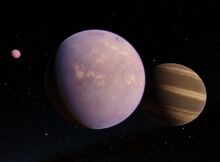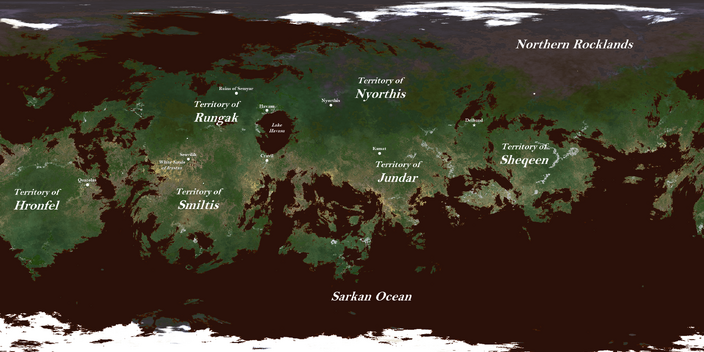Irastan was a temperate planet located on the edge of the Outer Territories in the Fiplas sector at the end of the Elsor Route. It was formally known as Levantia and was the original homeworld of the Levantians, who were ousted by the Shosars in 22,779 B.W. following the end of the Dune War. The planet was controlled by the Shosars, a sentient race of reptilian humanoids originally from the Shosa system.
Astrographic Information[]
Irastan was located on the edge of the Outer Territories in the system of the same name at the endpoint of the Elsor Route. Because of its isolated position in the galaxy, it was rarely visited by outsiders with exception to traders and suppliers. Irastan orbited Zeda, one of two stars in the Irastan system, and was the fourth planet from its sun.
A typical day on Irastan lasted 223 days (or 5,352 hours) while it orbited Zeda once every 133 days. These conditions resulted in extremely long intervals of sunlight and darkness, in which the ancient Levantians had based their religion on.
Climate and Terrain[]

The White Sands of Irastan, located within Smiltis territory.
The surface of Irastan varied in temperature mostly dependent on the state of rotation. For 1,338 hours (or 56 days) the planet was bright and warm with temperatures fluctuating from 25 to 40 degrees celsius. Another 1,338 hours were spent in pitch black, with only distant starlight lighting the landscape. This prolonged darkness dropped the temperature dramatically to -15 to -30 degrees. Water on the planet was a unique red color, similar in appearance to blood. Precipitation in the form of rain or snow, also red, was common on Irastan and was used as a source of nutrients for vegetation which had evolved without the need of sunlight for energy. Following a snowfall, the landscape was covered in a red layer of snow.
The majority of Irastan was tundra and grassland, with scattered deserts and canyons carved into the landscape. 60% of its landmass was part of one large continent, spanning from east to west, with small islands close to its coasts. A large uninhabited polar region was located in the south, separated from the mainland by the Sarkan Ocean. Vegetation in the form of grasses and small bushes were common on most of the planet with exception to its desert regions. These areas were covered in white sand dunes which were home to an assortment of creatures as well as Shosar settlements. Tundra was the most prominent type of terrain on Irastan. Usually shrouded in a thick reddish mist, these regions were dotted by water springs and geysers, including the Hullick Fountains west of Lake Havasu.
The Irastan landmass was divided into six territories, each led by a Shosar vaadin (Delbeesh for leader), with cities and settlements located in all parts of the world. The former Levantian civilization built cities based in canyons, which protected them from predators and harsh weather.
There were four major cities on Irastan, each controlled by a different Shosar tribe. The city of Delband was the most frequented by offworlders as it was the only Alliance-aligned city on Irastan. It was based in and around the canyon systems east of the Mahu Mountains in Sheqeen territory. Other Shosar territories were ruled independent from the Alliance and were isolated from intergalactic affairs. Visitors on Irastan were restricted from traveling outside Sheqeen for their own safety. Despite this, historians and archaeologists from the Core Worlds have done extensive research on ancient Levantian ruins in less hospitable regions.

The ancient city of Semyar, nestled in a canyon in Rungak territory. Semyar was built by the Levantians in around 24,500 B.W. It was an important trading hub in the east before being taken over by the Shosars.
Historic Timeline[]
~26,550 B.W.
- Hundreds of years following the conception of the Levantian race, a small group comes together to build their first city, originally named Boz, in the rocky central region of Levantia. By 26,450 B.W., the population of Boz was around 40,000.
~26,400 B.W.
- The Levantians branch out from Boz, and other small settlements are built close by.
~24,600 B.W.
- An extremely cold season hits Boz unexpectedly. Thousands of Levantians freeze to death while others abandon their city and make way towards warmer regions.
- The survivors find their way to a temperate area north of Lake Havasu (originally called the Tralic Sea), guarded by mountains. The settlement is named Havasu.
~24,500 B.W.
- The city of Semyar is constructed northwest of the Tralic Sea.
~24,000 B.W.
- The Levantians are quick to develop new technology and develop their own method of space travel, limited to traveling within the Levantian system. Explorers discover suitable conditions for sustaining life on Celado II, a small temperate desert moon of Celado Prime. Colonists establish the settlement of Olinbas on the moon. The planet and moons were named after Dobik Celado, a former official of Boz whose efforts saved the Levantians from extinction hundreds of years prior.

Celado II, with Celado I and Celado Prime in the background.
23,643 B.W.
- A controversial decision made by Levantian officials on Irastan moves its prisoners to Celado II, much to the dismay of existing colonists on the moon.
22,779 B.W.
- The planet of Levantia is discovered by the Shosars, a sentient race of reptilians living in the nearby Shosa system. Looking to establish a new colony, the Shosars invade the planet. With the element of surprise and technical superiority, the Shosars drive the Levantians from their cities and kill off the rest in a conflict known as the Dune War. As a last resort, communication is cut off from Celado II to prevent the complete demise of their race. By 22,650 B.W., the Levantians are all but extinct on their homeworld. The planet is briefly called New Shosa and colonies are established in former Levantian cities and in other regions. Focused on the rebuilding of their acquired world, the Shosars turn a blind eye from the rest of the system, unaware of the Levantian colony on Celado II.
- Knowledge of their homeworld's invasion reaches the ears of Celado II's prisoners. With only a small number of permanent colonists on the moon, the prisoners break free and take control of Olinbas. At this time there were around 3,000 colonists (including 500 guards) living in Olinbas compared to 5,500 prisoners.
~21,500 B.W.
- By this time, the Shosars have built settlements in all parts of New Shosa. The already ancient city of Boz was reoccupied and renamed Kamat. Divisions in leadership result in groups splitting apart from the primary government, establishing independently ruled territories.
20,180 B.W.
- The planet is renamed Irastan.
18,624 B.W.
- Irastan is discovered by a survey vessel with the First Galactic Republic. Contact is made with with the Sheqeens, a sect of Shosars dedicated to technology who were generally less aggressive than the other sects. A minor trade connection is established with close by Republic worlds.
13,109 B.W.
- Irastan becomes a partial member of the Second Galactic Republic. The planet is represented in the Republic Senate by Sheqeens. Other sects of Shosars are uninterested in off world affairs and keep to themselves.
5,530-24 B.W.
- Due to its location, Irastan remained mostly unscathed during the Hyperspace War. A number of Sheqeen Shosars volunteer to assist the Republic.
961 B.W.
- Irastan formally becomes a part of the Elsor Route. The Sheqeens export weaponry and building materials.
39 B.W.
- Early in the Great War, the Galactic Empire attempted to capture the planet, but were met with strong resistance. During the Battle of Irastan, Imperial troops attacked the city of Delband, but were no match against the superior weaponry of the Sheqeen. Dedicated to conquering more strategic worlds than Irastan, the Empire withdrew its fleet from the system for the remainder of the war.
415 A.W.
- Irastan sides with the Collective Confederate Systems with hopes of increasing trade with other parts of the galaxy. The Elsor Republic is ousted from the system.
461 A.W.
- Following the collapse of the CCS, Irastan joins the Galactic Alliance of Free Worlds with sole representation by the Sheqeens.
